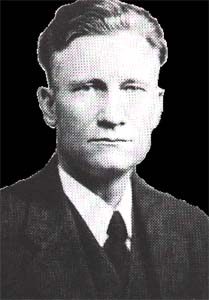
James P. Cannon
Born : February 11, 1890
Died : August 21, 1974
James Patrick Cannon was born in February 1890 in Rosedale, Kansas (today a part of Kansas City). His socialism came from his father, an Irish republican and Populist who had become a socialist in 1897.
Cannon joined the Socialist Party in 1908; he left it in 1911 to join the more militant Industrial Workers of the World. In 1912-14 he was a travelling organiser and agitator for the IWW in the Midwest and during the war he was active in its Kansas City branch.
Following the 1917 Russian Revolution, Cannon rejoined the SP to link up with its developing pro-Bolshevik left wing. In June 1919 he was Kansas City delegate to a national SP left-wing caucus in New York. At the SP’s August 1919 convention in Chicago, the left wing split. Two communist parties were formed; Cannon and the Kansas City left wing adhered to John Reed’s Communist Labor Party. Cannon was elected CLP secretary for Missouri and organiser for Missouri, Kansas and Nebraska.
In December 1921, the two communist parties fused to form the Workers Party of America. Cannon was its first national chairman (until 1923) and delivered the keynote address at the convention. He was a member of the Central Executive Committee from 1920 to 1928 and of the Executive Council from 1922 to 1928. He was a prominent party spokesperson through the 1920s.
In July 1925 Cannon played the key role in founding the International Labor Defence, a united-front organisation dedicated to defending all class-war prisoners. Cannon was ILD secretary from its inception until his expulsion in 1928.
In June 1922 Cannon was the US delegate to the Executive Committee of the Communist International in Moscow. He spent seven months there and was a delegate to the Fourth Congress of the Comintern. He made four further trips to the Soviet Union, representing the US party at Comintern meetings. On his last trip he was a delegate to the Comintern’s Sixth World Congress, July-August 1928.
At this congress he accidentally obtained a copy of Trotsky’s criticism of the draft program of the Comintern and was won to the perspectives of the Left Opposition. Returning to the US, in October 1928 he was expelled from the CP for �Trotskyism�, along with Max Shachtman and Martin Abern.
Cannon gathered more supporters and established the Communist League of America, as the US organisation of the International Left Opposition. In November 1928 the first issue of the Militant came out. The CLA held its first convention in Chicago in May 1929.
In 1934 the CLA gained national prominence through its leadership role in the Minneapolis Teamsters strikes. In December the CLA fused with A.J. Muste’s American Workers Party to form the Workers Party of the United States.
In the latter part of 1934 Cannon travelled to France for a leadership meeting of the International Communist League (the successor body to the International Left Opposition) and to help resolve the severe internal problems of the French Trotskyists. He also met Trotsky at his temporary home in the French Alps.
In mid-1936 the WPUS entered the Socialist Party as a public faction in order to meet up with the left wing developing there. Forced out in the latter part of 1937, the Trotskyists took the bulk of the SP youth and radical workers with them. At a conference in Chicago, the Socialist Workers Party was founded on New Year’s Day 1938.
In the summer of 1938, Cannon travelled to England to try to promote the unity of the various Trotskyist groups there. Then he went to France to participate in the founding conference of the Fourth International in Paris in September. His work there was highly appreciated by Trotsky.
In 1939-40 a struggle took place in the SWP over the attitude to be taken toward the Soviet Union in the coming war. With Trotsky, Cannon played the main role in arguing that the USSR should be defended against imperialism, despite Stalin. Max Shachtman, James Burnham and Martin Abern split in April 1940, taking 40% of the organisation with them to form the Workers Party.
In July 1941, Cannon and a number of other SWP and Teamster leaders in Minneapolis were indicted for conspiring to overthrow the US government. Eventually Cannon and 17 other party leaders were sentenced to prison terms of 12-16 months. Cannon was in jail from the end of 1943 until January 1945.
He served as the SWP’s national secretary until 1953 when Farrell Dobbs took over. From then until his death he was the national chairman of the party.
In 1952-53 Cannon led the fight to defend the party’s revolutionary perspectives against the minority led by Bert Cochran (see the section Defending the Revolutionary Party in this volume).
In 1952 Cannon and his companion, Rose Karsner, moved to Los Angeles. Cannon died there in August 1974.
David Holmes
Resistance Books